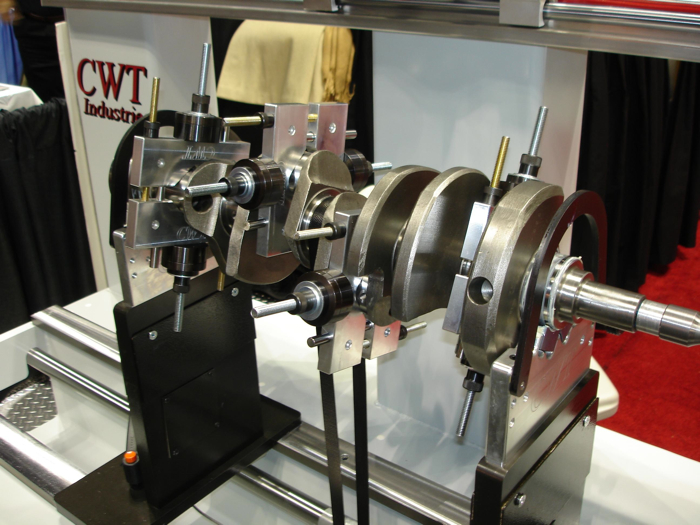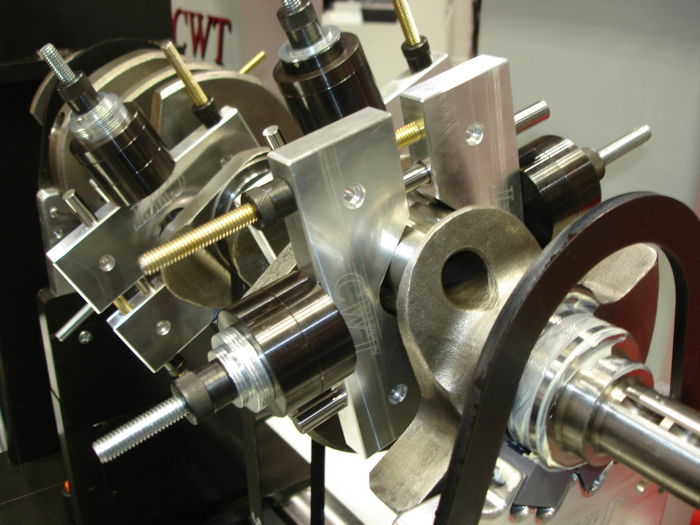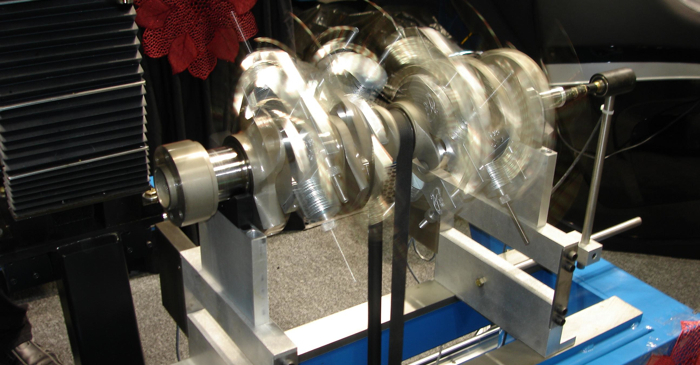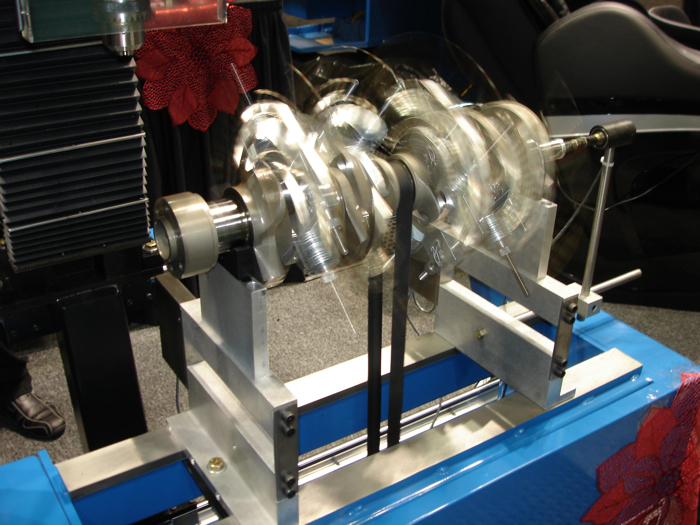
Our readers are certainly familiar with the benefits of engine balancing, and few would disagree that balancing is a worthwhile effort whether you are rebuilding a stock engine or putting together a performance motor. A small imbalance will multiply exponentially as engine speed increases, generating forces that create severe vibrations that may eventually lead to bearing or crankshaft failure.
The basics of engine balancing have not changed over the years, but some of the nuances have. The equipment used to balance crankshafts has also become more sophisticated, faster to learn and easier to use thanks to smarter software, better user interfaces and more informative display graphics.
Most of today’s balancers can balance a crank in less time with fewer spins than the type of equipment that was commonly used in the past. So if you are still using an antiquated machine to spin-balance cranks, you should check out the latest generation of balancers to see what you are missing.
The basic procedure for balancing an engine is still the same. You generally start by weighing all of the reciprocating components (rods, pistons, wrist pins, piston rings and bearings) on a highly accurate digital gram scale to establish which rod and piston are the lightest. The rest of the rods and pistons are then machined to match the weight of the lightest ones in the set.
The next step depends on the type of engine (inline, V-block or horizontally opposed) and the type of crankshaft. If we are talking about a straight inline four-cylinder engine, the next step would be to mount the crankshaft in a balancer, spin it and make the necessary corrections to achieve neutral balance. If an engine is internally balanced, you spin the crank by itself. If it is externally balanced, you mount the flywheel or flexplate on one end of the crank, and the harmonic dampener on the other and balance the rotating assembly as a unit.
Bobweights to simulate the rotating and reciprocating mass of the rods and pistons are required for most V-block engines, but are usually not necessary with flat plane four-cylinder cranks because the rod journals are positioned 180 degrees apart. Two pistons (#1 and #4) are at Top Dead Center (TDC) while the other two (#2 and #3) are at Bottom Dead Center (BDC). The two pistons that are up alternate compression strokes as do the two pistons that are down. The typical firing order would be 1-3-4-2 every 180 degrees of crankshaft rotation. Thus, the reciprocal forces generated by the two pistons traveling up cancel out the forces generated by the two pistons traveling down – assuming all of the reciprocating components are of equal weight.
It’s the same story with a horizontally opposed four or six-cylinder engine like that in a Porsche or Subaru. You don’t need to use bobweights to balance a flat plane crank in one of these engines because the reciprocal forces generated by the pistons that are opposite each other cancel each other out.

Bobweight Debate
Some engine builders disagree with these generalizations and say you get a better balance with bobweights on a four-cylinder flat plane because the weights help simulate the bending forces the crank experiences in a running engine. Others say it’s a waste of time to create and install bobweights on a four-cylinder crank. There’s also a chance one or more bobweights might not be the correct weight or not positioned correctly on the rod journals which could throw the balance job off.
If a particular balancing technique works for you and you haven’t had any problems with it, it’s probably best to stick with the technique you have been using. On the other hand, if you feel there’s room for improvement, trying a different technique (bobweights or no bobweights) might give you better results.
Spin Balancing
If an engine is an inline six-cylinder, bobweights are generally not used when balancing the crank. The throws are positioned 120 degrees apart so the engine will fire evenly. Similar to a four cylinder, the reciprocating forces generated by the pistons cancel each other out so the crank can be spin balanced without bobweights.
With V6, V8, V10 and V12 engines, it’s a different story because the cylinders are not in the same plane and the forces generated by the up and down motions of the pistons and rods are in different directions and at different times. With most V8 engines, the cylinder banks are 90 degrees to each other and the crankshaft is a cross plane design with the rod throws spaced 90 degrees apart. With V6 engines, you might have a 90-degree block, a narrower 60-degree block, or in the case of a VW a very narrow 18-degree block. Consequently, the forces generated by the rods and pistons reciprocating in different planes require bobweights to simulate the effects when balancing the crank.
To create a bobweight, you have to separate rotating mass from reciprocating mass. Rotating mass is the big end of the connecting rod and rod bearings. Reciprocating mass is the small end of the rod, the wrist pin, piston and rings. Figuring out which is which requires weighing the big end of the connecting rod on a scale while the small end is supported by a pin or hook. Once you know the big end weight, you can subtract that from the total rod weight to determine the weight of the small end of the rod. Then you add that number to the weight of the wrist pin, pin clips or retainers (if used), piston and ring set to determine the reciprocating weight. Several grams (2 to 5) also need to be added to the total to compensate for motor oil in the bearings and on the parts. The bobweight can then be assembled with weighted washers until the desired weight is achieved.
With most 90-degree V-blocks, each bobweight is equal to 100 percent of the rotating mass (big end of each rod), plus 50 percent of the reciprocating mass (small end of the rod plug, the piston, wrist pin and rings), times two (2X) because two rods share each crank journal. This is the standard balancing formula that applies to most 90-degree V-blocks for street and performance use.
The bobweights are installed evenly on the center of each crank journal. The crank is then spun on the balancer so its sensors can detect the amplitude and location of any imbalance in the crank. The machine shows you where to remove (or add) metal to correct the imbalance. It may take several spins and corrections before the desired degree of balance is finally achieved.
A stock Chevy 350 will usually run smooth enough if it is balanced to one ounce-inch (28.35 grams). One ounce-inch means there is one ounce of imbalance one inch from the centerline of the crank. A better spec to aim for with a stock build would be 1/2 ounce-inch (14 grams) or less. Some OEMs and production engine rebuilders say they balance their engines to 1/4 ounce-inch (7 grams). Some are even closer. The balance tolerance for current Ford V-6 engines for normal (not HP) applications is now 0.16 ounce-inch or less. Other OEMs are using similar specs. This would be a good target for a well-balanced street/strip engine. For a high revving race engine, however, many experts recommend getting the balance down to 2 grams or less!
The lower the number you are aiming for, the more spins and corrections it will take to get there. The resolution on most balancers today is under a tenth of a gram, with a repeatability factor of about plus or minus half a gram. Realistically you’ll never achieve zero (perfect) balance because it’s beyond the resolution of the balancer and the bobweights. Besides, nobody really needs an absolute zero balance. If you can get it down to 2 grams or less, that’s good enough. There’s also the variable of how much oil affects balance inside a running engine at high RPM. It can change depending on oil viscosity, whether pistons use oil squirters or not, bearing clearances, oil pressure and flow, and coatings on parts.
Modifying Counterweights?
All kinds of modifications can be made to the counterweights when balancing a crankshaft. Sometimes the counterweights will be machined to a knife-edge to reduce windage and drag, or cut down to provide extra piston clearance in a stroker motor. Any modification that changes the shape and mass of the counterweight will affect balance.
Typically, you drill holes of various diameters and depths into the counterweights to remove metal when lightening is required. But holes can create extra windage and drag. So if you want to be really slick, you can machine down the outer circumference of the counterweight slightly, or to make the counterweight thinner by removing metal from its side. Turning down the outer diameter of the counterweights may also be necessary if the pistons and rods weigh significantly less than the stock components.
Turning down the outside diameter of the counterweights removes weight where it has the most effect in terms of inertia. A lighter crank will rev faster than a heavier crank, obviously, but reducing the mass of the counterweights too much can also have a detrimental effect on torsional control. That’s because the mass of the counterweights provides momentum that helps dampen the twisting motions the crank experiences when the engine is running. Loss of torsional control can lead to excessive motion, metal fatigue and crank failure. The same thing can happen if the harmonic dampener on the front end of the crank is removed or is too small or too light for the application (bigger is actually better).
The mass and position of the counterweights on a stock crank are designed to offset the weight of the pistons and rods. If you are building a performance motor with longer or heavier rods and the counterweights don’t have enough mass to offset the reciprocating weight, gun drilling the rod journals lightens the crank a bit and effectively increases the effect of the counterweight.
If you are buying a custom aftermarket crank, weigh the rods and pistons first to determine the reciprocating weight. Then order a crankshaft that has a target bobweight slightly heavier than what you need to balance the engine. This will make balancing the crank quicker and easier because you’ll have to drill fewer holes.
Another option is to externally balance the engine if the counterweights are not heavy enough to offset the pistons and rods. You get the crankshaft as close to neutral balance as you can, then bolt on the flywheel and damper and add weight to these components as needed to balance the entire assembly. However, the external weight places high stress loads on both ends of the crankshaft which can cause deflection and exasperate the original unbalance.
If you can’t get a crank to balance because there isn’t enough metal in the counterweights to offset the pistons and rods (which may be a problem with long stroke motors), a hole can be drilled parallel to the crankshaft axis in the counterweights to accept plugs of Mallory heavy metal (tungsten). The plugs should be installed with a slight interference fit and/or locking compound so they can’t work loose.
Another option is to externally balance the engine if the counterweights are not heavy enough to offset the pistons and rods. Once you get the crankshaft as close to neutral balance as you can, bolt on the flywheel and damper and add weight to these components as needed to balance the entire assembly.
Overbalancing
For most performance applications, using 50 percent of the reciprocating weight for the bobweights when balancing the engine yields good results. All engines will experience harmonic vibrations at certain RPMs, but will generally run fairly smooth throughout the RPM range using the 50 percent figure. But there are exceptions.
High-revving engines (say 8,000 to 12,000 RPM), as well as engines that are blown, turbocharged or run on nitrous may benefit from “overbalancing” the crankshaft. Overbalancing adds an additional 1 or 2 percent to the reciprocating weight when creating the bobweights. The extra mass helps offset the extreme reciprocating forces that are generated at really high engine speeds and loads. Overbalancing an engine at 51 or 52 percent of the reciprocating weight often helps smooth out high speed vibrations. It may also add some additional horsepower that would otherwise be lost due to ignition and valve timing fluctuations.
Overbalancing can smooth things out at high speeds and loads, but it also makes the engine unbalanced at lower RPMs. Usually that doesn’t matter because a race engine doesn’t spend much time idling or running at low speed or load. And at low speed, any imbalance that’s present has much less effect.
In some cases, slightly underbalancing an engine can smooth it out at certain speeds, too. Using 48 to 49 percent of the reciprocating weight can sometimes smooth out a large displacement long stroke engine that otherwise tends to feel rough with a standard balance.
Figuring how much overbalance or underbalance to use in a given application is a black art based on engine displacement, bore, stroke, rod length, rod ratio, speed and load. Some people claim they have formulas that predict how much overbalance or underbalance should work. But it usually takes some experimentation to find the “sweet spot” that produces the best results in any given engine.
Overbalancing usually does NOT provide any benefits for street engines or performance engines that don’t rev beyond 7,000 RPM, and may in fact be detrimental because of the vibrations it may produce at lower speeds.
V6 Balancing
With V6 engines, the percentage of reciprocating weight varies depending on the angle between the cylinder banks and whether the crankshaft is even-fire or odd-fire. For a typical 90-degree V6, the recommended reciprocating weight for the balancing bobweight is often 50 percent, the same as a 90-degree V8. But for some engines, like an externally balanced Buick 3800 V6, the recommended reciprocating weight is only 36.6 percent. Ford says to use 44 percent of the reciprocating weight for its odd-fire 4.0L V6, but to use 50 percent of the reciprocating weight if a 4.0L V6 has a split-pin, even-fire crank. For its 90-degree 3.8L V6, Ford recommends using 39.4 percent of the reciprocating weight for the bobweight.
The bottom line here is that the recommended reciprocating weight for the bobweight can vary depending on the application. So make sure you find out what the recommended percentage is so the bobweights will be correct for the application.
Odd Applications
Bobweights are also required for inline five-cylinder engines as well as high performance V8s that use a flat plane crank. Ford has gotten a lot of publicity recently about the flat plane crank it is using in its 2016 Mustang GT350. The 5.2L “Voodoo” V8 has been optimized for track performance with an over-square bore-to-stroke ratio of 94mm to 92.7 mm. The naturally aspirated engine revs to 8,250 RPM and makes 526 horsepower at 7,500 RPM and 429 ft. lbs. of torque at 4,750 RPM.
Ford went with a flat plane crank instead of a conventional cross plane crank because the flat plane crank improves the firing order and exhaust scavenging of the engine. Also, the crank has smaller, lighter counterweights that allow the engine to rev and decelerate more quickly, which is exactly what you want in a track car motor. The trade-off, however, is increased roughness due to second order vibrations produced by the flat plane crank and revised firing order. You can’t balance those kinds of vibrations out of the motor by rebalancing the rotating assembly. The only way to tune them out is with counter-rotating balance shafts, which Ford chose not to use because of added weight and complexity that isn’t needed in a track motor. This engine was not designed to be a smooth-running street engine like the Mustang’s regular 5.0L V8, so the extra vibrations are a consequence of the change from a cross plane crank to a flat plane crank. Ford says it spent a lot of time beefing up the bottom end of the block to handle these vibrations. Specially tuned hydroelastic motor mounts are also used to help isolate the engine vibrations from the body.
Several years ago, Lingenfelter built a 358 cubic inch Chevy LSX engine with a flat plane crank to see what it would do. The naturally aspirated engine put out 621 horsepower at 9,000 RPM.
Ferrari has also used flat plane cranks in many of its engines, and flat plane cranks have also been used in Formula 1 and Indy engines. Most of these applications are smaller displacement, short stroke big bore engines that can rev like crazy. These engines have a lot of vibrations, which are mitigated somewhat by the shorter stroke of the crankshaft and the higher RPMs. Even so, all the recent buzz over Ford’s new 5.2L Voodoo V8 has some people wondering if a flat plane crank is the way to go in spite of its balance and vibration issues. According to one aftermarket crankshaft manufacturer, flat plane cranks have some advantages and make sense in certain applications (like a track car), but they would not be a good choice for a typical street performance engine. Switching to a flat plane crank would also require a different cam and different exhaust headers.
Balancing Wrap-Up
The typical aftermarket automotive engine balancer only checks first order vibrations. It is not designed to detect second and third order vibrations. That said, it’s impossible to build an engine that is perfectly balanced from idle to peak RPM. All engines will experience some type of harmonics within various speed ranges.
The goal of balancing an engine, therefore, is to end up with a balance that delivers the smoothest results over the broadest range of engine speeds (stock and street applications), or the smoothest balance within the engine’s peak power band (race engines). If a standard balance doesn’t get you there, you may have to experiment with some overbalance or underbalance.















